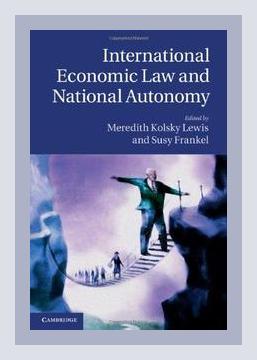Business Law and EthicsInternational Trade Law
**
“International Economic Law and National Autonomy” by Meredith Kolsky Lewis is a comprehensive examination of the interplay between international trade regulations and the self-governance capabilities of nations. The book belongs to the International Trade Law category and delves into the tension between global economic rules and national policy-making autonomy. It discusses various agreements, institutions, legal frameworks, and case studies to illustrate the challenges and opportunities in balancing international obligations with domestic interests.
Introduction: The Balance Between Global and National Interests
Lewis opens the book by setting the stage for understanding the historical context and evolution of international economic law. She emphasizes the need for a balance where nations can engage in global trade while maintaining their sovereignty. Here are some specific actions suggested:
- Policy Formulation: Governments should draft policies that align with international trade agreements while safeguarding national interests.
- Stakeholder Engagement: Encouraging dialogue between policymakers, industry leaders, and civil society to ensure comprehensive and balanced trade policies.
Chapter 1: The Framework of International Trade Agreements
This chapter provides an overview of key international trade agreements, such as the General Agreement on Tariffs and Trade (GATT) and the World Trade Organization (WTO). Lewis explains how these agreements establish rules that member countries must follow, which can sometimes infringe on national autonomy.
- Example: The GATT/WTO Dispute Settlement System.
- Action: Legal professionals and policymakers should familiarize themselves with the dispute resolution mechanisms to better advocate for their national interests within the framework of international law.
Chapter 2: Navigating Sovereignty and Compliance
Lewis discusses the concept of sovereignty in the context of international economic law, differentiating between ‘hard’ and ‘soft’ law obligations. She explains how ‘soft’ laws, while not legally binding, can still influence national policies through mechanisms like the Organisation for Economic Co-operation and Development (OECD) guidelines.
- Example: OECD guidelines on multinational enterprises.
- Action: Corporations should align their business practices with OECD guidelines to enhance their international reputation and avoid non-compliance issues.
Chapter 3: Impact of Trade Agreements on Domestic Regulations
In this chapter, the book explores how international trade agreements affect domestic regulations, particularly in areas like environmental standards and labor laws. Lewis argues that trade agreements often require countries to modify their domestic laws to comply with international rules.
- Example: North American Free Trade Agreement (NAFTA) and its environmental provisions.
- Action: Environmental policymakers must stay informed on current trade agreements to ensure domestic environmental regulations are in compliance while still achieving local objectives.
Chapter 4: Economic Integration and National Policy Space
Lewis examines economic integration through trade agreements like the European Union (EU) and the challenges countries face in maintaining national policy space. She highlights the tension between regional integration and national autonomy, illustrating this with several case studies from the EU.
- Example: EU regulations on agricultural subsidies.
- Action: Agricultural policymakers should negotiate for terms that allow some leeway in applying subsidies to protect local farmers’ interests.
Chapter 5: The Role of Non-Governmental Organizations
This chapter looks at the influence of non-governmental organizations (NGOs) in shaping international trade policies. Lewis points out that NGOs can be powerful advocates for maintaining national autonomy in the face of globalization.
- Example: The role of Greenpeace in advocating for environmental policies within the WTO framework.
- Action: Civil society actors should engage with international economic organizations to advocate for policies that reflect national priorities and values.
Chapter 6: Case Studies in Balancing Trade and Autonomy
Lewis includes various case studies to show how different countries have successfully or unsuccessfully balanced international trade obligations with national autonomy.
- Example: The United States’ approach to protecting its steel industry through tariffs.
- Action: Trade negotiators should analyze similar case studies to learn from past strategies and outcomes when drafting trade agreements.
Chapter 7: Recommendations for Maintaining National Autonomy
In the concluding chapter, Lewis offers practical recommendations for countries to maintain their autonomy while engaging in international trade. She emphasizes the importance of strategic negotiation, robust legal frameworks, and the development of domestic capabilities.
- Example: South Korea’s strategy in maintaining control over its technology sector despite international trade pressures.
- Action: Countries should invest in domestic innovation and education to build sectors that can withstand international competition and policy shifts.
Practical Steps for Policymakers and Legal Professionals
- Strategic Negotiation: When entering international agreements, prioritize clauses that allow for national policy adjustments.
- Domestic Law Harmonization: Regularly review and harmonize domestic laws with international obligations to ensure compliance without sacrificing autonomy.
- Capacity Building: Invest in expertise and institutional capacity to effectively negotiate and implement trade agreements.
- Engagement with International Bodies: Actively participate in international forums to influence rule-making processes and safeguard national interests.
Conclusion: Striking a Balance
Meredith Kolsky Lewis’s “International Economic Law and National Autonomy” provides a nuanced exploration of how countries can navigate the complex landscape of international trade law without compromising their sovereignty. The book emphasizes the importance of balancing global trade commitments with national policy-making freedom, offering a wealth of examples and actionable insights for policymakers, legal practitioners, and academics.
By examining real-world examples and providing practical recommendations, Lewis equips readers with the tools necessary to understand and address the challenges inherent in global economic integration. This balanced approach ensures that nations can reap the benefits of international trade while preserving their ability to govern autonomously, ultimately fostering a more equitable and sustainable global economy.
